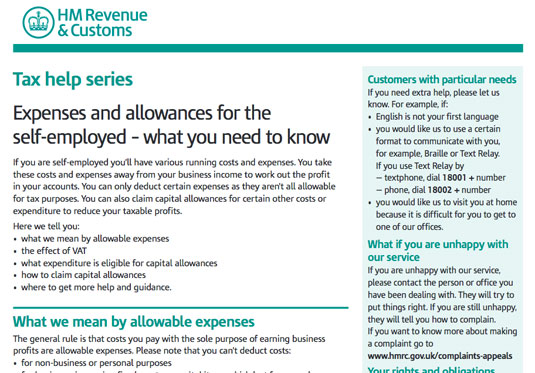The freelancer's guide to tax
Working for yourself means sorting your own tax affairs, but it's not difficult, and there's plenty you can do to reduce your annual bill.

Whether you're a freelancer working from home or in a studio, being your own boss comes with much responsibility. But short deadlines, how to draw your next piece and the constant worry of cashflow aren't the biggest fears of freelance designers. Nope, that's the tax man, but he needn't be, because getting your tax situation under control and in hand is far easier than you might assume.
First things first. In the UK, when you take on any freelance work you need to tell HMRC that you're earning money on a self-employed basis. Even if you don't expect to earn enough in the coming year to pay tax at all, you still need to tell HMRC about any freelance work and you may be fined if you don't.
Freelance options
There are two options available to you as a freelance designer: you can either set up as a sole trader or create your own limited company. The decision has implications for tax, legal and financial responsibilities, the amount of paperwork you will need to complete, and how you are viewed by your peers and clients.
The downsides of being a limited company are that there are more rules and regulations to abide by, accountancy fees tend to be higher, and the penalties for getting your paperwork wrong are greater. You will also have to pay corporation tax and you can't just withdraw money from the business without formally recording it as a salary, dividend or loan.
On the plus side, setting up as a limited company grants access to the many clients and design agencies who don't like working with sole traders. There's also the fact that your personal assets are protected against company debts, so in situations where the client passes on the responsibility and risk from a project to you – which is an everyday part of life as a freelancer – personal property, such as your house, will have a level of protection.
What can you claim?
Whether you decide to operate as a sole trader or a limited company, one of the best things about working freelance is the value of expenses you can claim against tax – which is much more than most people think. There's no fixed list of items that can be claimed, but the general rule is that if you've purchased something that's used in the running of your business, it's an expense.
It might seem logical that you shouldn't be able to claim against an expense that you actually get some personal enjoyment out of, but HMRC isn't always the fun police. For example, as a freelance graphic designer you would be able to claim against a subscription to a graphic design magazine like Computer Arts, because it's relevant to your business's operations.
Daily design news, reviews, how-tos and more, as picked by the editors.
Other expenses you might want to claim may include memberships of museums and professional organisations, cultural events, art supplies, business cards, printing, studio rent, tax preparation and legal fees, telephone and internet charges and travel to design conferences.

You can even claim for a proportion of expenses that are not wholly work related, such as lighting or heating if you do your working from home.
Once you see all those expenses adding up and your tax bill going down, it can be tempting to try stretching the definition of 'business use' a little, but be warned – the tax authorities carry out random audits on freelancers, so you will need to be able to back up everything you claim for. On that note, filing all your receipts and invoices methodically is vital, because if you're audited the tax authorities will be expecting to see all of these, and in good order.
It's also important to ensure you get your head around capital allowance, because this is something sole traders often overlook when calculating their tax contributions. Capital allowance applies to something that you buy to enable your business to function, such as a computer or a car, for example. You can either claim this amount all at once, or spread the depreciation amount over a number of years.
For example, if you purchase a computer for £3,000, you can either claim the full £3,000 against your first year tax bill (this applies even if you already owned the computer) or claim a percentage of the value instead and save some for the next year. You can find full details of expenses and allowances for the self-employed, claiming capital allowances, and how VAT can affect your allowable expenses on the government services website here.
Paying up
However, the biggest mistake most freelancers make isn't claiming the wrong amounts against tax, but not preparing for the day that tax needs to be paid. If you've been used to having your tax deducted at source in a PAYE job, it can be a real shock when you have to pay a massive bill before the end of January, or face automatic and ever-increasing fines if you don't.
You really need to stay on top of your records as you go, and because there's no certainty in the life of freelancer, it's best to err on the side of caution and put more money aside than you estimate you'll need in a tax-free, interest-paying ISA.
Words: Tom Dennis
Illustration: Becca Allen

This article first appeared inside Computer Arts issue 249, a special issue looking at how to power up your skills as a freelancer and more, on sale here.
Like this? Read these!

The Creative Bloq team is made up of a group of art and design enthusiasts, and has changed and evolved since Creative Bloq began back in 2012. The current website team consists of eight full-time members of staff: Editor Georgia Coggan, Deputy Editor Rosie Hilder, Ecommerce Editor Beren Neale, Senior News Editor Daniel Piper, Editor, Digital Art and 3D Ian Dean, Tech Reviews Editor Erlingur Einarsson, Ecommerce Writer Beth Nicholls and Staff Writer Natalie Fear, as well as a roster of freelancers from around the world. The ImagineFX magazine team also pitch in, ensuring that content from leading digital art publication ImagineFX is represented on Creative Bloq.
